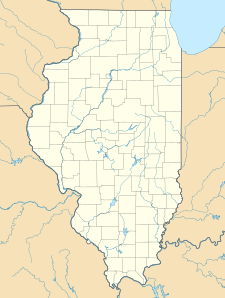Ray Norbut State Fish and Wildlife Area facts for kids
Quick facts for kids Ray Norbut State Fish and Wildlife Area |
|
|---|---|
|
IUCN Category IV (Habitat/Species Management Area)
|
|
| Location | Pike County, Illinois, USA |
| Nearest city | Griggsville, Illinois |
| Area | 1,140 acres (460 ha) |
| Established | 1970 |
| Governing body | Illinois Department of Natural Resources |
The Ray Norbut State Fish and Wildlife Area is a special park in Pike County, Illinois, covering about 1,140-acre (460 ha). It's located near Griggsville. This park sits right next to the Illinois River. Most of the land is made of steep hills, called bluffland, which are part of the river's valley. The area is covered in thick forests. People often visit to hunt whitetail deer here. The park also includes Big Blue Island, which is a 100-acre (40 ha) island in the Illinois River. The Illinois Department of Natural Resources (IDNR) manages and takes care of this park.
Contents
Nature and Wildlife at Ray Norbut
Forests and Trees
The main part of the Ray Norbut State Fish and Wildlife Area has forests with oak and hickory trees. These are called temperate hardwood forests. A deep, steep-sided valley named Napoleon Hollow runs through the park. Rainwater flows down this valley from the forest into the Illinois River.
These oak and hickory trees produce many acorns. Acorns are a favorite food for whitetail deer and many small animals that live in the forest. Scientists took samples from two white oak trees in 2001. They found that one tree was 378 years old, and the other was 322 years old! Imagine how much history those trees have seen.
Big Blue Island and River Life
Big Blue Island, located in the Illinois River, is home to different kinds of trees. You'll find wetland trees like cottonwood, silver maple, and willow trees there.
Both the island and the riverbanks nearby are important places for bald eagles. These majestic birds come here in the winter. They hunt and eat fish from the Illinois River, including Asian carps and other fish that live near the bottom of the river.
History of Ray Norbut Area
Early Settlers and Villages
Scientists have found signs that hunters used the Napoleon Hollow area for more than 7,000 years. The rich natural resources of the region attracted early European-American settlers. Around 1840, frontiersmen started a village called Big Blue Hollow at the southern end of what is now the state park. For many years, this village was a local hub for hunting, fishing, and grinding grain. However, when railroads were built in Illinois, they bypassed Big Blue Hollow. This meant the village slowly became smaller and eventually disappeared.
Another village site within the park, Griggsville Landing, had a similar story. This landing was a busy stop for steamboats before the Civil War. But just like Big Blue Hollow, it couldn't survive when railroads became the main way to travel and transport goods. A small factory ruin, the Griggsville Landing Lime Kiln (built around 1850), is still there today. It reminds us of the village that once thrived.
Park Establishment and Name Change
The state of Illinois bought about 860 acres (350 ha) of land in and around Napoleon Hollow in 1970. They set aside this land for hunting and called it the Pike County Conservation Area. The park grew even larger in 1988 when another 280 acres (110 ha) was added.
In 1995, the Illinois Department of Natural Resources (IDNR) changed the park's name. It went from Pike County Conservation Area to Ray Norbut Fish and Wildlife Area. This was done to honor Ray Norbut, who had been in charge of the state parks division for a long time.


